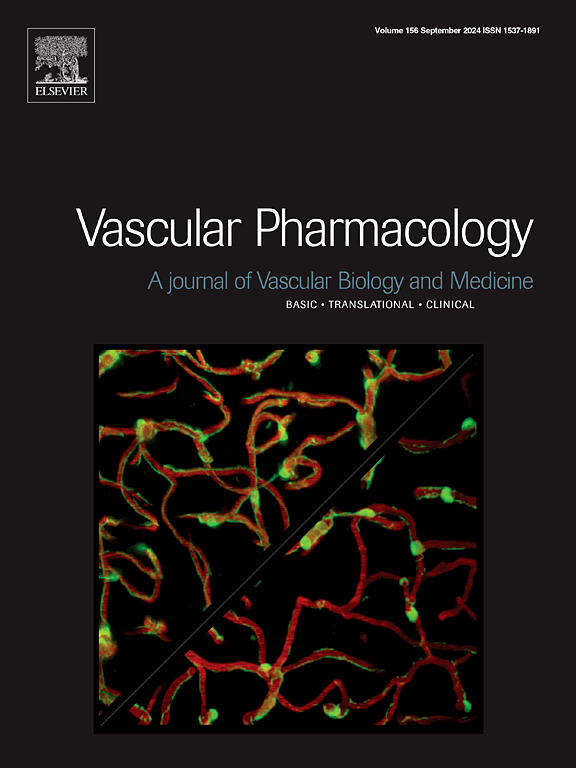Targeting the Ca2+ signaling toolkit as an alternative strategy to mitigate SARS-CoV-2-induced cardiovascular adverse events
IF 3.5
3区 医学
Q2 PHARMACOLOGY & PHARMACY
引用次数: 0
Abstract
Ca2+ signaling events are essential for maintaining cardiovascular health, regulating critical functions in both endothelial and cardiac cells. SARS-CoV-2 infection impinges this delicate balance, leading to severe cardiovascular complications. SARS-CoV-2 binds to the ACE2 receptor on endothelial and cardiomyocyte surfaces, triggering abnormal increases in intracellular Ca2+ levels that promote endothelial dysfunction, inflammation, and hypercoagulation. In endothelial cells, this dysregulation activates a pro-inflammatory state and compromises vascular integrity. In cardiomyocytes, SARS-CoV-2-induced Ca2+ imbalances contribute to arrhythmias and heart failure by promoting abnormal Ca2+ cycling and energy metabolism disruptions. Additionally, the cytokine storm associated with COVID-19 amplifies these effects by further altering Ca2+ handling, enhancing inflammatory responses, and promoting thrombosis. Targeting Ca2+ channels, particularly endolysosomal two-pore channels, represents a promising therapeutic approach to counteract SARS-CoV-2’s effects on Ca2+ dynamics. Several FDA-approved drugs that modulate Ca2+ signaling could be repurposed to prevent viral entry and mitigate cardiovascular damage. Understanding these Ca2+-related mechanisms offers valuable insights for developing treatments to reduce cardiovascular risk in COVID-19 and potentially future viral infections impacting the cardiovascular system.

靶向Ca2+信号工具箱作为缓解sars - cov -2诱导的心血管不良事件的替代策略
Ca2+信号事件对于维持心血管健康,调节内皮细胞和心脏细胞的关键功能至关重要。SARS-CoV-2感染会破坏这种微妙的平衡,导致严重的心血管并发症。SARS-CoV-2与内皮细胞和心肌细胞表面的ACE2受体结合,引发细胞内Ca2+水平异常升高,从而促进内皮功能障碍、炎症和高凝。在内皮细胞中,这种失调激活了促炎状态,损害了血管完整性。在心肌细胞中,sars - cov -2诱导的Ca2+失衡通过促进异常的Ca2+循环和能量代谢中断而导致心律失常和心力衰竭。此外,与COVID-19相关的细胞因子风暴通过进一步改变Ca2+处理、增强炎症反应和促进血栓形成,放大了这些影响。靶向Ca2+通道,特别是内溶酶体双孔通道,代表了一种有希望的治疗方法来抵消SARS-CoV-2对Ca2+动力学的影响。一些fda批准的调节Ca2+信号的药物可以重新用于防止病毒进入和减轻心血管损伤。了解这些Ca2+相关机制为开发降低COVID-19心血管风险的治疗方法以及潜在的未来影响心血管系统的病毒感染提供了有价值的见解。
本文章由计算机程序翻译,如有差异,请以英文原文为准。
求助全文
约1分钟内获得全文
求助全文
来源期刊

Vascular pharmacology
医学-药学
CiteScore
6.60
自引率
2.50%
发文量
153
审稿时长
31 days
期刊介绍:
Vascular Pharmacology publishes papers, which contains results of all aspects of biology and pharmacology of the vascular system.
Papers are encouraged in basic, translational and clinical aspects of Vascular Biology and Pharmacology, utilizing approaches ranging from molecular biology to integrative physiology. All papers are in English.
The Journal publishes review articles which include vascular aspects of thrombosis, inflammation, cell signalling, atherosclerosis, and lipid metabolism.
 求助内容:
求助内容: 应助结果提醒方式:
应助结果提醒方式:


